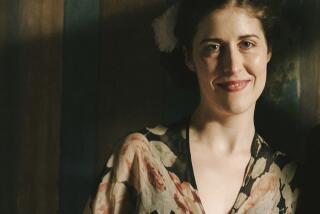Deeply Felt Portraits From Life’s Accidents
When we first see 4-year-old Kamon Michael Temlin, his world has been turned upside down. Still belted into his car seat, the car lying on its roof on the side of the road, his mother dead behind the wheel. The young child is about to be thrown to the wolves, as the dialectics of race, family and the sanctity of childhood become ripe material for Joanna Scott’s new book, “Make Believe.”
The novel owes its title to the prodigious imagination of Kamon--called “Bo” for “hobo” because he likes to wander off alone. The child of unmarried teenage parents, Bo faces a reality that is far less idyllic: Bo’s father, Kamon Sr., was killed in a random mugging two months before Bo’s birth; now his mother is gone as well.
Bo is soon entangled in a custody battle between grandparents and between races. The Gilberts are black, the Ganzes white. The Gilberts are loving and easy; the Ganzes tight and disturbed. The Ganzes threw their daughter out when she got pregnant; the Gilberts took her in.
When Bo recovers from his injuries--both from the accident and from emergency surgery for a condition initially undetected by the hospital--he goes to live with the Gilberts, who are happy to take Bo under their sheltering wing and dote on him as the posthumous son of their favorite child. As memories of the accident and his mother recede, Bo’s other grandparents grimly realize that they could profit financially from suing for custody of Bo--that if they win, they can file a malpractice suit against the hospital on the boy’s behalf. A judge grants the Ganzes guardianship, on the assumption that the white grandparents are more stable than the Gilberts. Bo is yanked out of his shelter and installed among strangers.
Scott is a skilled portraitist, subtle and generous; the characters in “Make Believe” are the book’s greatest strength. She carries off the incoherent imagination of a toddler with honor. Yet it’s her darkest creation who stands out: Eddie Ganz, Bo’s step-grandfather, moral majority of one, whose piety and clenched rectitude only partly conceal the inflamed bully within. Although it’s impossible to like him, Scott insists that we understand, even sympathize with him, that he is simply a man trying to do his best. It’s easier to like the Gilberts; Scott is dead on at the twittering anxiety these decent people feel in what proves to be a hostile white world.
“Make Believe” is filled with life’s tragic randomness, the telling split seconds that divide all right from all wrong. Each character clings to the narrow precipice over life’s maelstrom into which, Scott suggests, circumstances may pitch anyone at any moment.
But Scott falters with her slam-bam, pull-out-all-the-stops ending. She begins to get stagy; the sharply contrasted Gilberts and Ganzes begin to seem one-dimensional. Still, this book is deeply satisfying as one of fiction’s chief pleasures: to see, in literature, events and predicaments that mirror our own deepest uncertainties.
More to Read
Sign up for our Book Club newsletter
Get the latest news, events and more from the Los Angeles Times Book Club, and help us get L.A. reading and talking.
You may occasionally receive promotional content from the Los Angeles Times.









